Detection and Analysis of Partial Discharges in Oil-Immersed Power Transformers Using Low-Cost Acoustic Sensors
Abstract
:1. Introduction
2. Partial Discharge Detection Using the AE Method and Signal Processing Analysis
2.1. Piezoelectric Sensors
2.2. Experimental Setup
2.3. Time-Domain Analysis
2.4. Frequency-Domain Analysis
2.5. Time-Frequency Analysis
3. Data Processing Parameters
4. Conclusions
Author Contributions
Funding
Conflicts of Interest
References
- Tenbohlen, S.; Jagers, J.; Vahidi, F.; Bastos, G.; Desai, B.; Diggin, B.; Fuhr, J.; Gebauer, J.; Krüger, M.; Lapworth, J. Transformer Reliability Survey; Technical Brochure 642 CIGRE: Paris, France, 2015; pp. 94–102. [Google Scholar]
- Standard, I.E.C. High-Voltage Test Techniques: Partial Discharge Measurements; IEC: Geneva, Switzerland, 2000; pp. 13–31. [Google Scholar]
- Mor, A.R.; Heredia, L.C.C.; Muñoz, F.A. A Novel Approach for Partial Discharge Measurements on GIS Using HFCT Sensors. Sensors 2018, 18, 4482. [Google Scholar] [CrossRef] [Green Version]
- Jiang, J.; Zhao, M.; Zhang, C.; Chen, M.; Liu, H.; Albarracín, R. Partial Discharge Analysis in High-Frequency Transformer Based on High-Frequency Current Transducer. Energies 2018, 11, 1997. [Google Scholar] [CrossRef] [Green Version]
- Vaillancourt, G.H.; Malewski, R.; Train, D. Comparison of Three Techniques of Partial Discharge Measurements in Power Transformers. IEEE Trans. Power Appar. Syst. 1985, PAS-104, 900–909. [Google Scholar] [CrossRef]
- Tenbohlen, S.; Denissov, D.; Hoek, S.M.; Markalous, S.M. Partial Discharge Measurement in the Ultra High Frequency (UHF) Range. IEEE Trans. Dielectr. Electr. Insul. 2008, 15, 1544–1552. [Google Scholar] [CrossRef]
- Partyka, M.; Bridges, G.E.; McDermid, B.; Black, T.; Kordi, B. UHF Measurement of Partial Discharge on Stator Bars Using Patch Antennas. In Proceedings of the 2019 IEEE Electrical Insulation Conference, Calgary, AB, Canada, 16–19 June 2019. [Google Scholar]
- Dukanac, D. Application of UHF Method for Partial Discharge Source Location in Power Transformers. IEEE Trans. Dielectr. Electr. Insul. 2018, 25, 2266–2278. [Google Scholar] [CrossRef]
- Ilkhechi, H.D.; Samimi, M.H. Applications of the Acoustic Method in Partial Discharge Measurement: A Review. IEEE Trans. Dielectr. Electr. Insul. 2021, 28, 42–51. [Google Scholar] [CrossRef]
- Ilkhechi, H.D.; Samimi, M.H.; Yousefvand, R. Generation of Acoustic Phase-Resolved Partial Discharge Patterns by Utilizing UHF Signals. Int. J. Electr. Power Energy Syst. 2019, 113, 906–915. [Google Scholar] [CrossRef]
- Qian, S.; Chen, H.; Xu, Y.; Su, L. High Sensitivity Detection of Partial Discharge Acoustic Emission within Power Transformer by Sagnac Fiber Optic Sensor. IEEE Trans. Dielectr. Electr. Insul. 2018, 25, 2313–2320. [Google Scholar] [CrossRef]
- Boya, C.; Ruiz-Llata, M.; Posada, J.; Garcia-Souto, J.A. Identification of Multiple Partial Discharge Sources Using Acoustic Emission Technique and Blind Source Separation. IEEE Trans. Dielectr. Electr. Insul. 2015, 22, 1663–1673. [Google Scholar] [CrossRef]
- Power, I.; Society, E. IEEE Guide for the Detection, Location and Interpretation of Sources of Acoustic Emissions from Electrical Discharges in Power Transformers and Power Reactors; IEEE C57.127-2007; IEEE: New York, NY, USA, 2019. [Google Scholar]
- Castro, B.; Clerice, G.; Ramos, C.; Andreoli, A.; Baptista, F.; Campos, F.; Ulson, J. Partial Discharge Monitoring in Power Transformers Using Low-Cost Piezoelectric Sensors. Sensors 2016, 16, 1266. [Google Scholar] [CrossRef] [PubMed] [Green Version]
- De Castro, B.A.; Brunini, D.D.M.; Baptista, F.G.; Andreoli, A.L.; Ulson, J.A.C. Assessment of Macro Fiber Composite Sensors for Measurement of Acoustic Partial Discharge Signals in Power Transformers. IEEE Sens. J. 2017, 17, 6090–6099. [Google Scholar] [CrossRef] [Green Version]
- Viera, M.A.A.; Aguiar, P.R.; Junior, P.O.; Alexandre, F.A.; Lopes, W.N.; Bianchi, E.C.; da Silva, R.B.; D’addona, D.; Andreoli, A. A Time–Frequency Acoustic Emission-Based Technique to Assess Workpiece Surface Quality in Ceramic Grinding with Pzt Transducer. Sensors 2019, 19, 3913. [Google Scholar] [CrossRef] [PubMed] [Green Version]
- Akiyoshi, D.F.; de Castro, B.A.; Leão, J.V.F.; Rocha, M.A.; Rey, J.A.A.; Riehl, R.R.; Andreoli, A.L. Evaluation of Low Cost Piezoelectric Sensors for the Identification of Partial Discharges Evolution. Proceedings 2018, 4, 36. [Google Scholar] [CrossRef] [Green Version]
- Binotto, A.; Castro, B.; Santos, V.; Rey, J.A.; Andreoli, A. A Comparison between Piezoelectric Sensors Applied to Multiple Partial Discharge Detection by Advanced Signal Processing Analysis. Eng. Proc. Multidiscip. Digit. Publ. Inst. 2020, 2, 55. [Google Scholar]
- Kundu, P.; Kishore, N.K.; Sinha, A.K. A Non-Iterative Partial Discharge Source Location Method for Transformers Employing Acoustic Emission Techniques. Appl. Acoust. 2009, 70, 1378–1383. [Google Scholar] [CrossRef]
- Kim, B.S.; Lee, S.H.; Lee, M.G.; Ni, J.; Song, J.Y.; Lee, C.W. A Comparative Study on Damage Detection in Speed-up and Coast-down Process of Grinding Spindle-Typed Rotor-Bearing System. J. Mater. Process. Technol. 2007, 187–188, 30–36. [Google Scholar] [CrossRef]
- Kunicki, M.; Cichoń, A.; Nagi, Ł. Statistics Based Method for Partial Discharge Identification in Oil Paper Insulation Systems. Electr. Power Syst. Res. 2018, 163, 559–571. [Google Scholar] [CrossRef]
- Raymond, W.J.K.; Illias, H.A.; Bakar, A.H.A.; Mokhlis, H. Partial Discharge Classifications: Review of Recent Progress. Meas. J. Int. Meas. Confed. 2015, 68, 164–181. [Google Scholar] [CrossRef] [Green Version]
- Liao, R.J.; Yang, L.J.; Li, J.; Grzybowski, S. Aging Condition Assessment of Transformer Oil-Paper Insulation Model Based on Partial Discharge Analysis. IEEE Trans. Dielectr. Electr. Insul. 2011, 18, 303–311. [Google Scholar] [CrossRef]


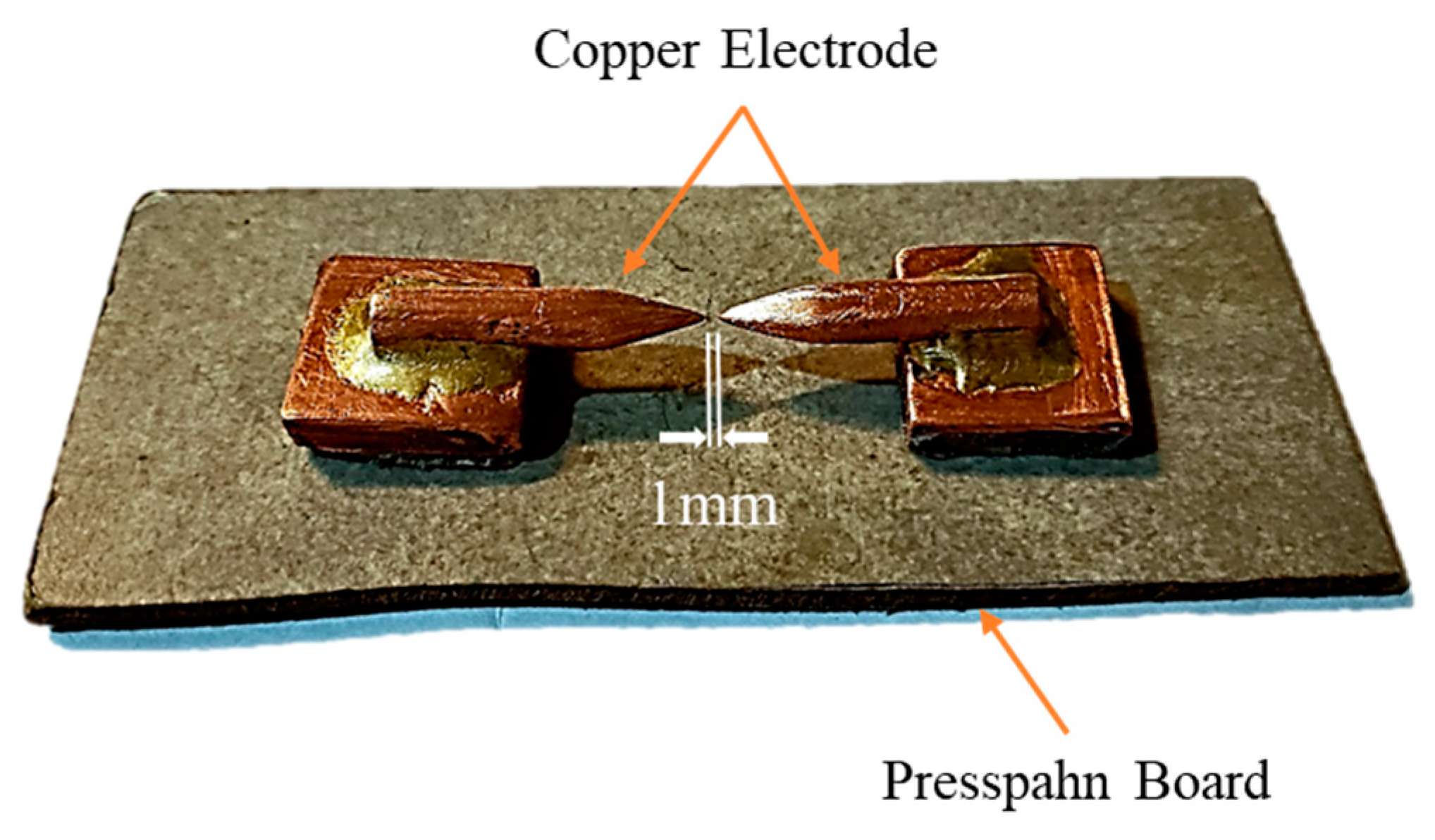
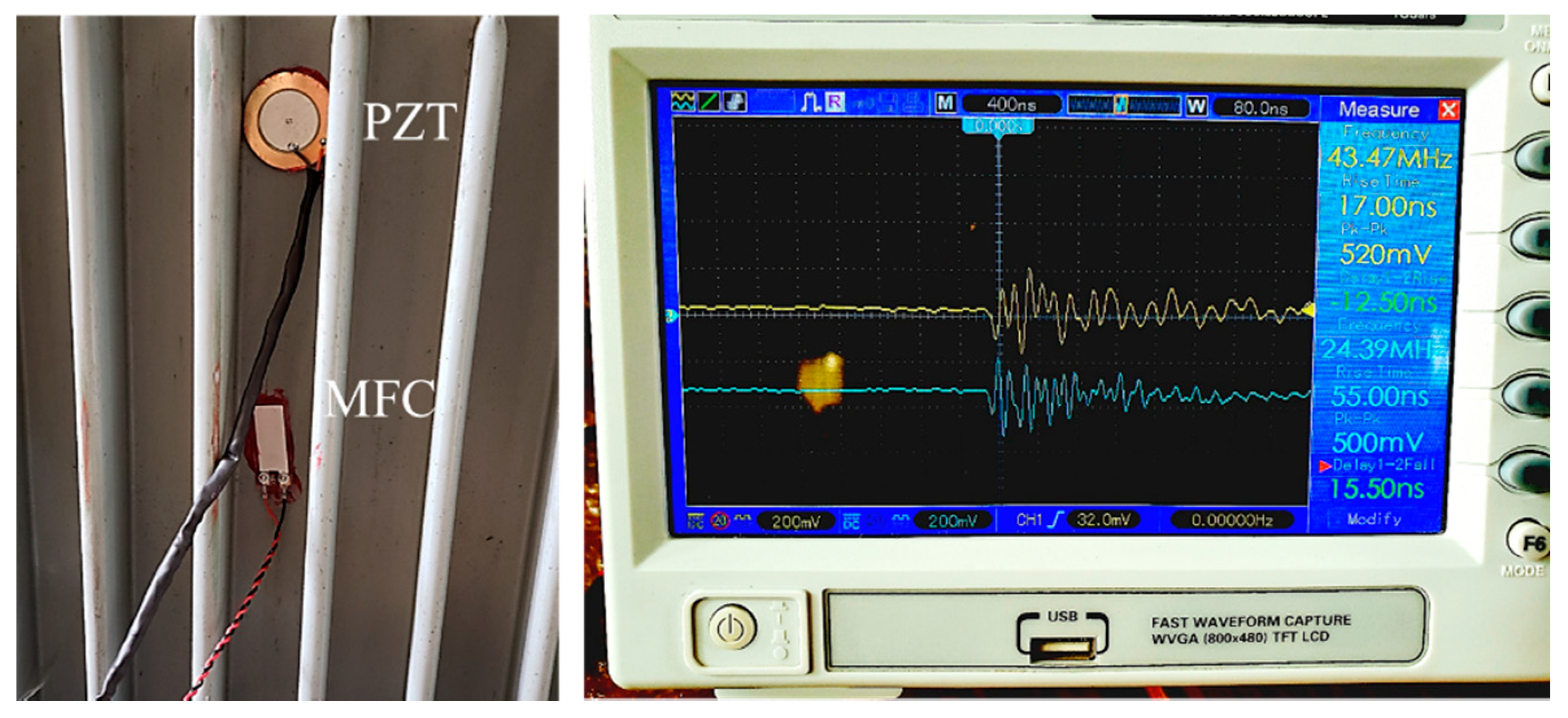
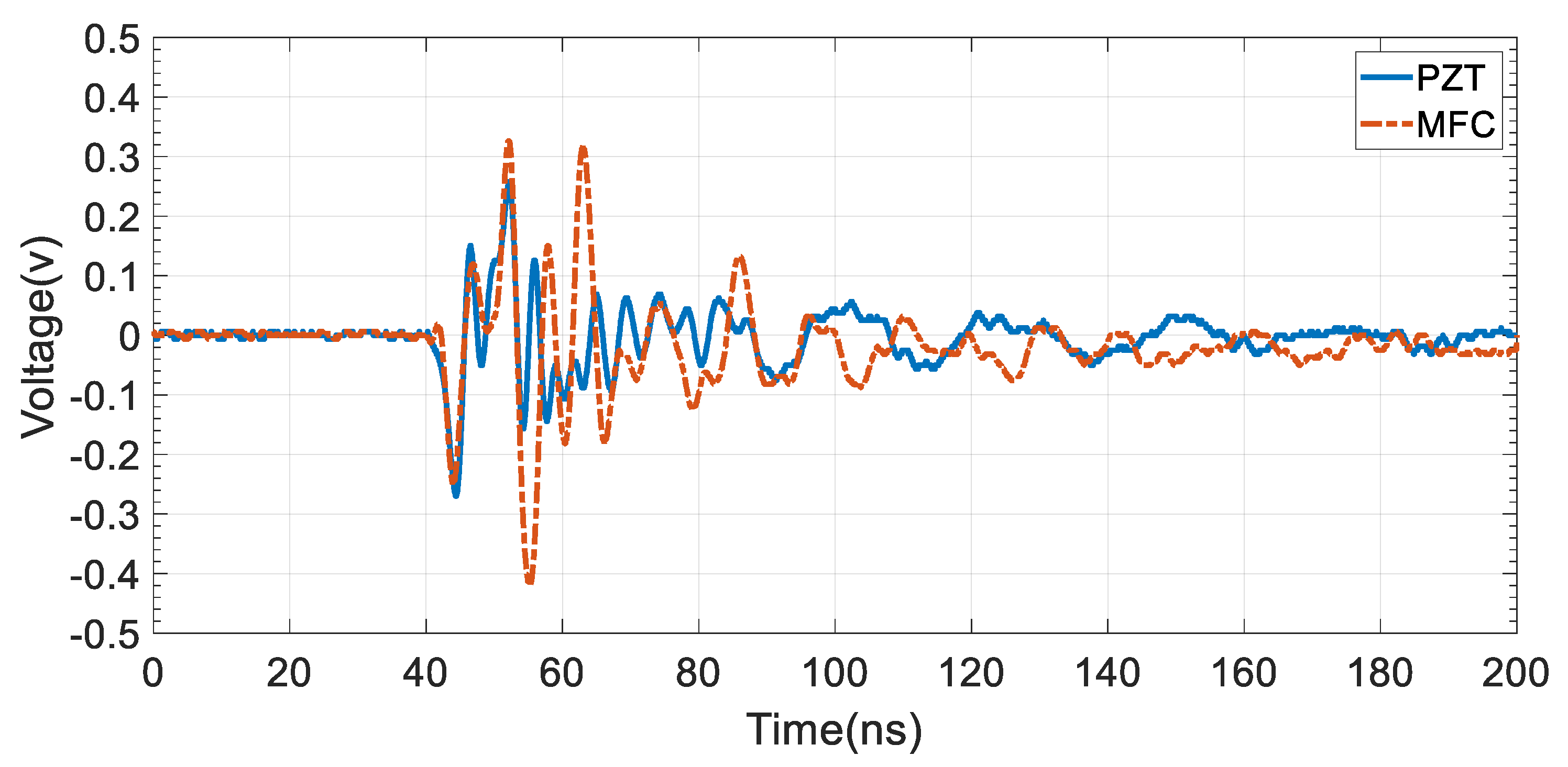


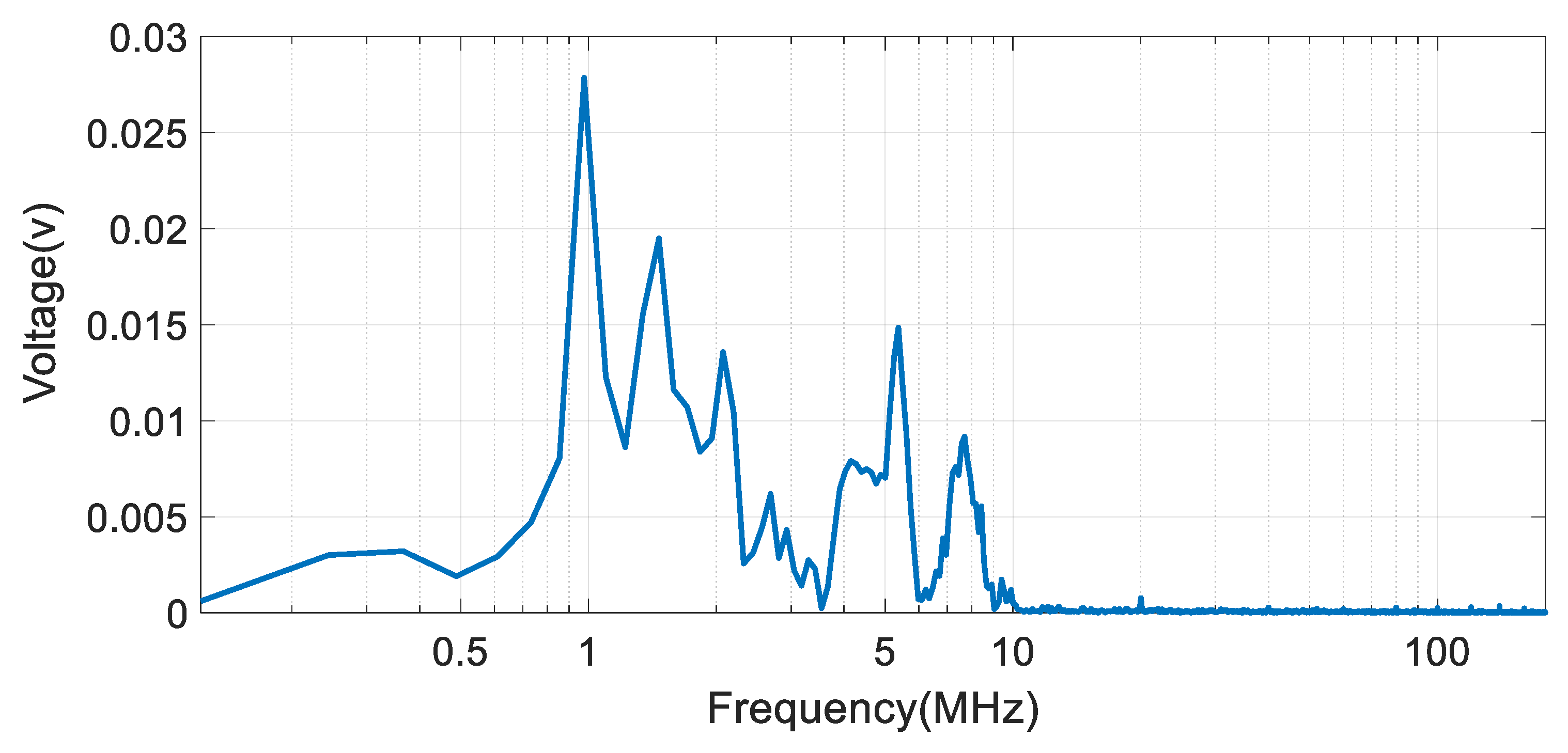


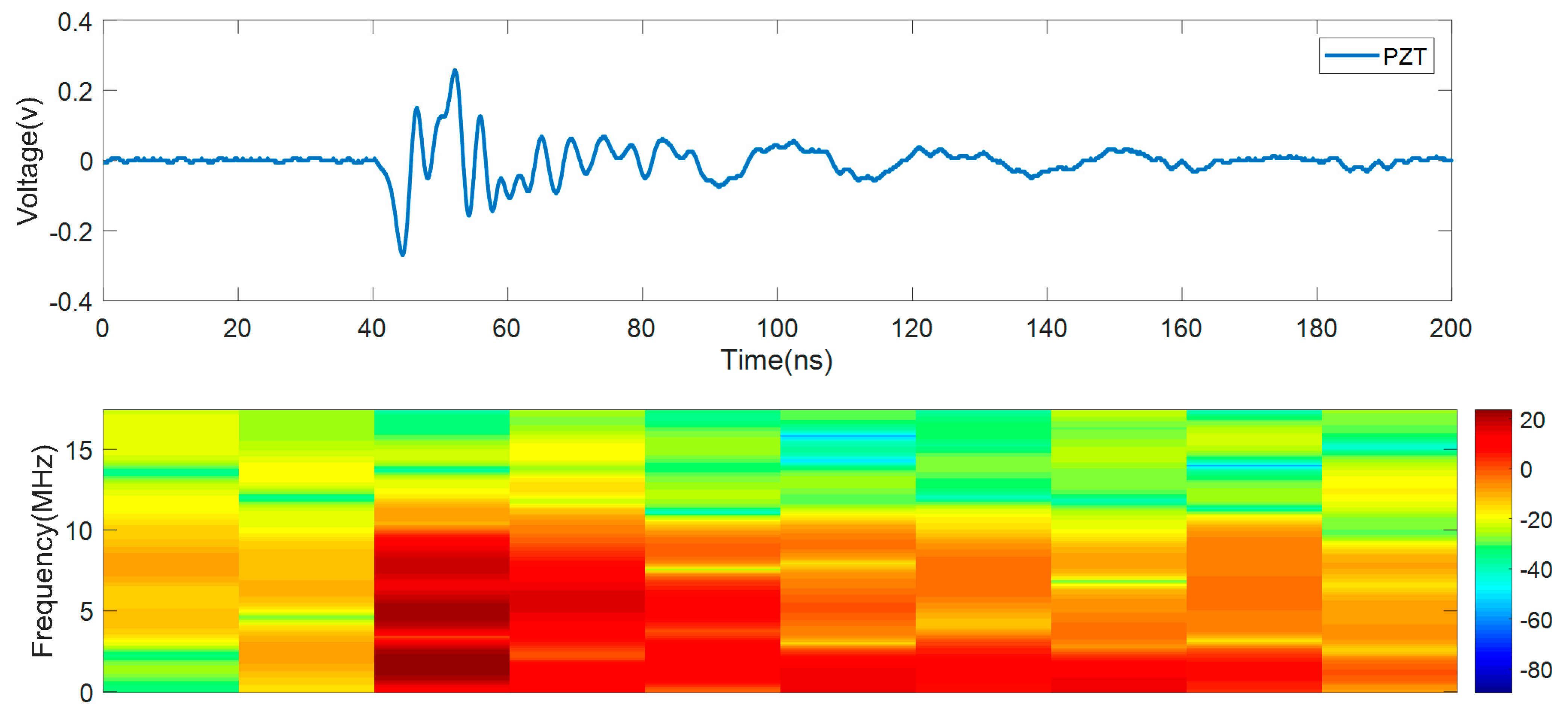
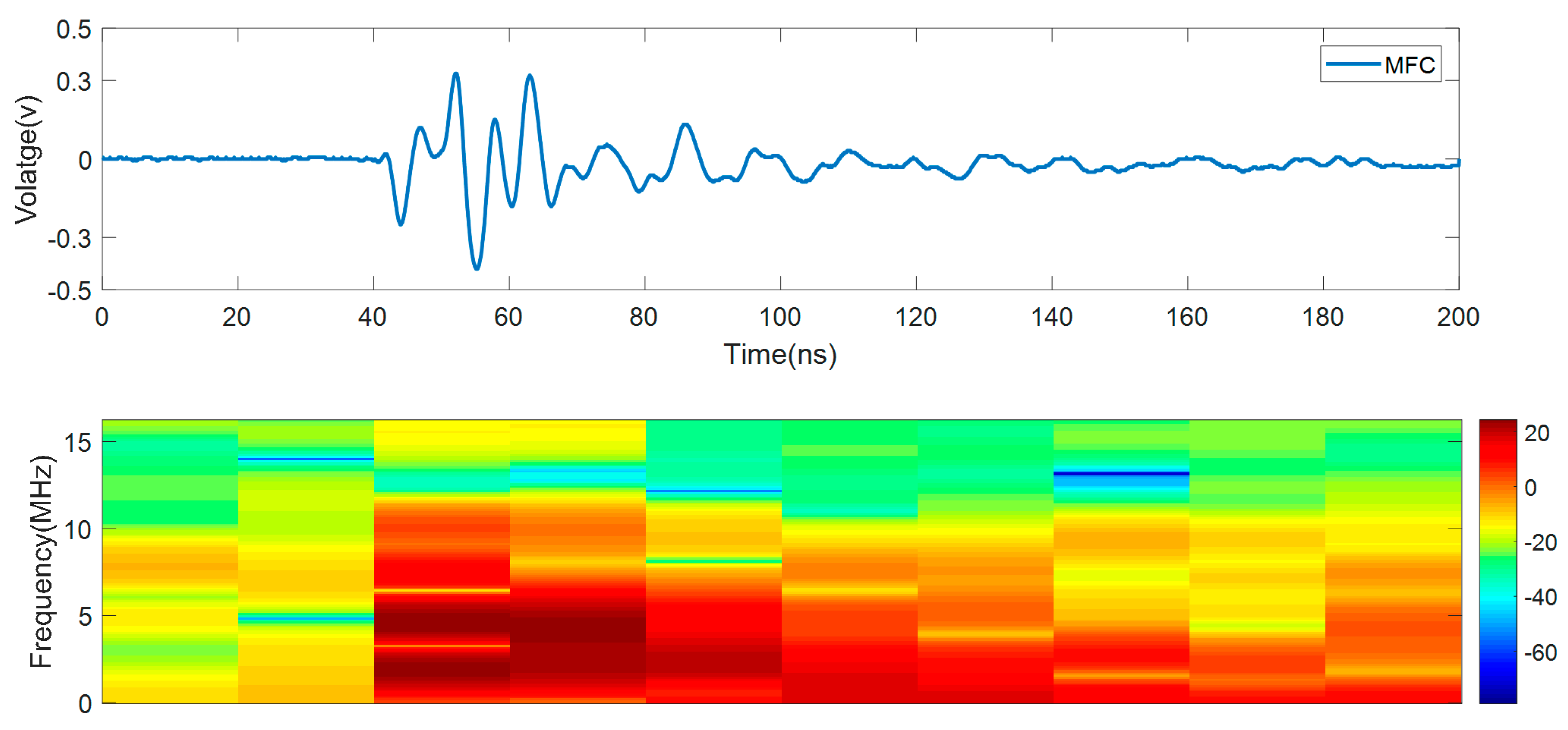
| Extracted Features | Amplitude (V) | Rise Time (ns) | Duration (ns) | Counts |
|---|---|---|---|---|
| PZT | 0.2573 | 6.3 | 56.55 | 8 |
| MFC | 0.3263 | 6.1 | 41.5 | 6 |
| Statistical Parameter | Max | Min | Mean | RMS | STD | Impulse Factor | Energy | Kurtosis | Skewness |
|---|---|---|---|---|---|---|---|---|---|
| PZT | 0.2573 | −0.2698 | −0.0029 | 0.0477 | 0.0476 | 93.5123 | 9.3092 | 12.0076 | −0.1379 |
| MFC | 0.3263 | −0.4204 | −0.0172 | 0.0745 | 0.0725 | 24.4610 | 22.7376 | 13.5322 | −0.2543 |
Publisher’s Note: MDPI stays neutral with regard to jurisdictional claims in published maps and institutional affiliations. |
© 2022 by the authors. Licensee MDPI, Basel, Switzerland. This article is an open access article distributed under the terms and conditions of the Creative Commons Attribution (CC BY) license (https://creativecommons.org/licenses/by/4.0/).
Share and Cite
Besharatifard, H.; Hasanzadeh, S.; Heydarian-Forushani, E.; Alhelou, H.H.; Siano, P. Detection and Analysis of Partial Discharges in Oil-Immersed Power Transformers Using Low-Cost Acoustic Sensors. Appl. Sci. 2022, 12, 3010. https://doi.org/10.3390/app12063010
Besharatifard H, Hasanzadeh S, Heydarian-Forushani E, Alhelou HH, Siano P. Detection and Analysis of Partial Discharges in Oil-Immersed Power Transformers Using Low-Cost Acoustic Sensors. Applied Sciences. 2022; 12(6):3010. https://doi.org/10.3390/app12063010
Chicago/Turabian StyleBesharatifard, Hamidreza, Saeed Hasanzadeh, Ehsan Heydarian-Forushani, Hassan Haes Alhelou, and Pierluigi Siano. 2022. "Detection and Analysis of Partial Discharges in Oil-Immersed Power Transformers Using Low-Cost Acoustic Sensors" Applied Sciences 12, no. 6: 3010. https://doi.org/10.3390/app12063010







